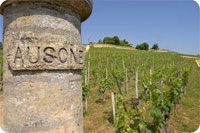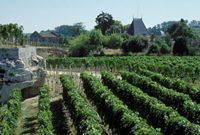 | The vineyards of St Emilion are divided into four main terroirs. To the far west, abutting Pomerol, is the Graves-St-Emilion, where Cheval-Blanc and Figeac are located on the Gunzian graves de feu. The second terroir is sand, and there are two principal regions; travelling east towards the town of St Emilion there are 1200 hectares, and along the banks of the Dordogne another 2000 hectares. Neither region is home to any of the highest ranked estates, as these are concentrated in the fourth region, the limestone côtes around St Emilion itself. Here is where we find the vineyards of Ausone, just below the carpark, a mere 7 hectares of vines mostly positioned in a suntrap, an amphitheatre of vines protected from frost. The vineyard can be micro-managed thanks to its small size, perhaps not quite treating each vine individually, but they certainly receive a lot of attention; there is bunch-thinning as well as leaf-thinning to ensure ventilation and ripening, and there is harvesting in tries, with several passes through the vineyard selecting only the ripest fruit. |
| The vines have a good age, nearing half a century on average, and are half Cabernet Franc and half Merlot, planted at a density of 6500 vines/ha. After the selective harvest described above, the fermentation is carried out in wood, with temperature regulation, and I was able to inspect some of the newest vats during my visit in 2008; how on earth they managed to transport the huge vessels to the vat room, at the top of that winding lane. Once finished with alcoholic fermentation the wine then undergoes malolactic in barrel, where it stays for up to 24 months. Before bottling it will be fined using egg whites, but it is not filtered. The very best barrels will go into Chateau Ausone, the grand vin, but some will be deselected for the estate's second wine, Chapelle d'Ausone. Overall the production is a little over 2000 cases, and limited quantities with supreme quality are two obvious features that have pushed Ausone prices into the stratosphere, putting the left bank first growths to shame.
|  |